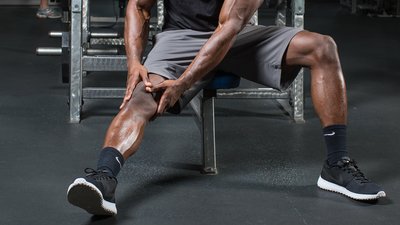As any veteran of the iron game knows, pain changes everything. It changes how you lift and how you live your life. But over the course of a lifter's career, chronic aches and pains unfortunately become an accepted price of training hard and heavy, even when they limit long-term performance and progression.
Why can ridding your joints and muscles of chronic dysfunction and lingering issues seem like such an impossible task? The problem is, the place where you're experiencing acute or chronic pain is not always the origin of the pain itself. Pain often presents in a different place than the area that is actually causing the pain.
If you suffer from one of these three commonly painful areas, consider a solution besides treating the pain directly. Improve the way you move, function, and feel in areas you would have never guessed were involved in causing the aches in the first place.
The Pain: Your Knees
The Fix: Your Hips
Over time, the knees eventually seem to flare up and become a linchpin of dysfunction for serious lifters who have some mileage in the squat rack. Squatting doesn't actually hurt your knees, though. The way you squat, and the immobile hips that are keeping you from a better squat, are the more likely culprits.
The knee joint has some big muscular attachments that course up the leg and insert into the hips and pelvis such as the quadriceps, hamstrings, and adductors. While the knee was built for stability, the hips were anatomically designed for mobility and are (theoretically) capable of moving in every plane of motion. But if your hips are immobile, your knees will often take the hit.
Improving the function and quality of your quads, hamstrings, and adductors is the single most beneficial way to take unwanted shear and compressional forces off the knee, period. From soft-tissue work to oscillatory stretching, pick a method and execute it through these muscle groups for pain-free knees.
As you're doing this, keep grooving and improving your squat pattern, going as remedial as necessary. You think you're too strong for goblet squats? I think not.
The Pain: Your Lower Back
The Fix: Your Pelvis
Is there any area of the body that is more chronically pissed off than the lower back? Probably not. To make matters worse, the number-one predictor of a future injury is a past injury, so the chances of re-injury are sky high.
But why does lower back pain tend to unpredictably flare its ugly head repeatedly over time with little to no warning signs? Well, if your movement patterns never change and you continue to load the positions that were faulty in the first place, you will never truly recover from this vicious pain cycle.
Stretching or foam rolling the muscles of your lower back won't do any good, and may even do damage. Instead, you need to improve the function of your pelvis.
As the spine moves into flexion (bending forward), one of the most important protective mechanisms the body demonstrates is rotating the pelvis posteriorly to minimize unwanted forces through the lower spine. The same can be said for extending the spine backwards, as the pelvis opens up the pain-free movement ranges of the spine by anteriorly tilting the pelvis forward. But for most people dealing with chronic lower-back pain, the pelvis presents with little to no movement in these situations. This creates more force through the spine as it moves into both flexion and extension.
By enhancing the function of the pelvis to rotate, we can protect the spine from chronic injuries and pain. Most times, activating and recruiting core stability can "unlock" the pelvis and add to function and coordinated movement. Old school rehab drills like the dead bug, active straight-leg raise, and planks can often take that parking break off your pelvis for improved movement capacity and function.
Doing controlled leg lowers with the opposite leg braced at 90 degrees can also work wonders.
The Pain: Your Elbows
The Fix: Your Shoulders
Similar to the knee joint, the elbow is a hinge-type joint that flexes and extends as its primary movements. And also similar to the knee, the elbow ends up a common pain point for lifters.
Also similar to the knee, that elbow pain you have been fighting through for years is likely not due to an elbow injury, but rather a problem coming from the more mobile joint up the chain. That joint is the shoulder, which is another commonly beat-up region for lifters.
"The elbow is slave to the shoulder" is a saying I use with many of my clients, because it paints a picture of why we are treating the shoulder when an elbow is pissed off and aching. The shoulder is the most mobile ball-and-socket-type joint in the body, but due to the complexity of the accompanying structures of the shoulder complex, the true shoulder joint—the gleno-humeral joint—can sometimes become dysfunctional and faulty with its movement mechanics.
So, is the answer to crank on your shoulder mobility? Not necessarily. Often, your shoulder is not in need of more mobility, but rather more stability, especially when it comes to training and lifting. A more stable shoulder complex means that the gleno-humeral joint can do what it was originally designed to do: act as a mobility joint to take undue stress off the elbows.
As simple as it sounds, perfecting shoulder static and dynamic stability from the push-up hold—and eventually the push-up—will help you reduce elbow pain in the long run.
Kind of like the goblet squat, you may think you're too strong, experienced, or elite to bother with push-up holds or push-ups for reps. Trust me, you're not. And if the reward might be finally—finally—being pain-free, what have you got to lose?

